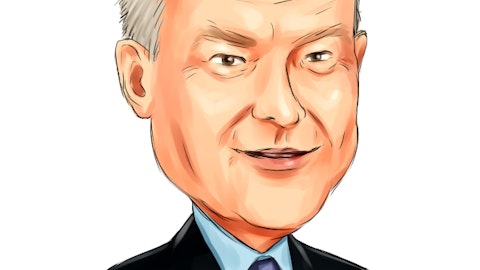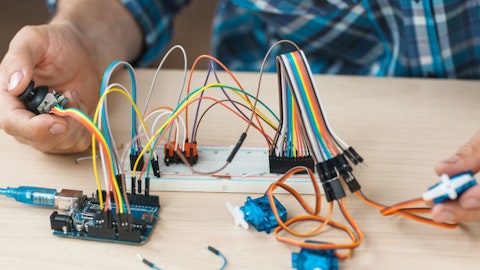Craig Ellis: Yes, thanks for taking the questions. And guys, I wanted to say congratulations on the cost and margin execution in a real tough environment. It’s not easy out there and nice to see gross margins hitting 35%. Colin, I wanted to start with a couple of clarifications really for you on the product side. So starting with the EV business and the plans for the China power substrate facility that you’re ramping up. Our checks are showing that there’s within China local manufacturers that are partnered up with other international entities a real significant ambition to grow silicon carbide output next year by pretty dramatic levels. And so the question is this is as you look at ramping up your facility, how would that facility size compare to the one that you have. I believe in operation now in Germany, and how quickly would you expect to ramp capacity there? And is it possible if demand came in early that you’d able to get to higher volume before calendar ‘25?
Colin Gouveia: Sure, I’ll start and then anyone can jump in to help me, Ram or Steve. So the way we’re looking at this factory, Craig, is that we’re putting it in different phases. So this first CapEx spend that we’re putting into this factory is Phase 1. But what we’re doing is, while we’re bringing up the entire production to be able to produce, we’re putting in the infrastructure so that we can add additional phases without having to add more large infrastructure spend. So we’re trying to think ahead and bring it up mindfully to match demand. But we’ll have a much larger infrastructure built out so that if demand goes faster than we think, we should be able to ramp up and get to Phase 2 much more quickly is how we’re thinking about it.
Craig Ellis: And how would Phase 1 or Phase 1 plus Phase 2 compare to the capacity that you already have in place over in Europe?
Colin Gouveia: We’re not really talking at this moment the size of the capacity, but what we believe is we’ve got it with the production improvements and operational efficiencies we’re driving out of our Eschenbach Germany plant. And with the phased approach for the curamik facility we put into China, we think we can match the ramp curve we have from our customers for the next several years. And we’ve also built in an upside case where we think we can meet that also. So ultimately, we’ll talk about capacity in terms of how much we have, but we’re not prepared to do that specific thing at this moment. Yes, so what we’ve shared publicly, Craig is that it’s about a $32 million to $35 million investment. And we look for about a three year payback on our investments.
Craig Ellis: Great. That’s really helpful, guys. I’m sorry.
Colin Gouveia: So I said that should give you an idea.
Craig Ellis: Yes, that’s real helpful. Second product related question for Colin. Colin, on the slide that you had that showed the longer-term drivers you talked about — you talked about personal electronics and the smartphone inventory issues that are out there. We’re hearing that while certainly iOS has been very strong over the last couple of years, obviously Android went into correction two years ago, but checks suggests that that’s finally starting to bottom out and we could start to see more normalized product cycles next year. So the question on that side of your business, what sense are you getting from customers about reengagement for new product activity next year?


